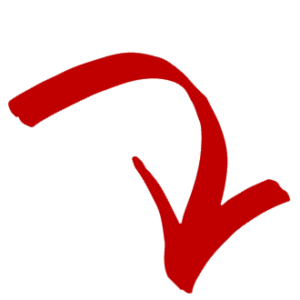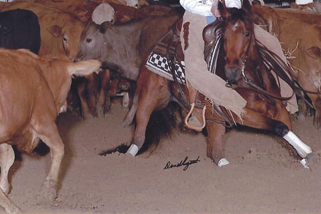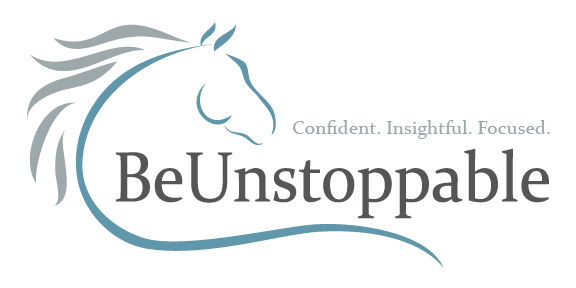Most cutting pictures are similar to the one above because they capture a beautiful deep stop at the beginning or middle of the turn.
A lot of herdwork and cutting instruction has to do with how to sit and use your feet before stops and during the middle of the turn.
For example, there’s a lot of discussion about sitting and waiting, etc.
There is another phase of the stop-turn sequence that is also critical to understand and ride correctly. It’s at the end of the turn where the horse completes the turn and then accelerates on the line.
The reason why the end of the turn is important is because this is where the horse:
-
Continues to read the cow undistracted (very important!)
-
Accelerates in a collected manner as he begins to move out of the turn and on ‘the line’
-
‘Stays on the line’ and does not go either towards the cow or does not move away from the cow as he travels across the arena (unless forced to do so)
To get a feel for this end part of the turn, I’m going to go out there into fantasy land for a moment, so bear with me here.
Imagine you are sitting in a swivel chair, like the chair at your desk.
Let’s pretend like you don’t have to do anything to make your swivel chair turn, but sit quietly. The chair turns on its own. You just have to look at something that will move your chair on its own.
As you sit in the chair, your feet are quiet and do not impede the movement of the chair.
Again, your job is to focus on whatever is moving the chair and allow it to turn on its own.
But then at the 180-degree mark, your feet need to do some coordinated and correct actions to accelerate the chair on a line and keep it from rotating more than 180 degrees.
With your fantasy chair, when you use your feet correctly, you could accelerate the chair on a straight line at the 180 mark and keep it parallel to the object that pulled you through the turn.
Okay… let’s come back now to working a cow.
The cow ‘pulls’ a horse through the turn, i.e., the horse waits for the cow to move and then turns with it (much on his own) in a rhythmic, synchronized and correct form manner.
The sequence is: the cow goes; the horse comes next; the horse brings the rider on the horse’s back.
At the end of the turn, the rider helps the horse move well, stay in position and travel correctly with the cow across the arena.
So, while the cow initiates the turn and dictates the speed of the turn, at the end of the turn, the rider’s feet make a huge difference for what happens next.
Just as in the chair analogy, for example, if you were rotating to the right, your right foot could keep the chair from over-rotating to the right and moving off of a 180-degree turn (if needed).
The difference between a chair and a horse (there are a lot of differences (-:) is that the cow-side leg is critical, too.
When used appropriately the cow-side leg ensures that the horse’s body complete’s the the turn and comes out of the turn in a collected way. It is used in coordination with the herd-side leg, which keeps the horse on the line.
Therefore, at the end of the turn, the rider not only accelerates the horse, but he or she can also help him move in a collected way and in a straight line.
As you become more aware of this end-of-the-turn moment, and you begin to feel that critical acceleration place, it will help you use your feet more effectively and more accurately.
In the meantime, you can ride your office chair! (-:
LET US KNOW YOUR THOUGHTS 


Thank you for your sharing. I am worried that I lack creative ideas. It is your article that makes me full of hope. Thank you. But, I have a question, can you help me?
Thanks for sharing. I read many of your blog posts, cool, your blog is very good.
I don’t think the title of your article matches the content lol. Just kidding, mainly because I had some doubts after reading the article.
Your point of view caught my eye and was very interesting. Thanks. I have a question for you.
I don’t think the title of your article matches the content lol. Just kidding, mainly because I had some doubts after reading the article.
Your article helped me a lot, is there any more related content? Thanks!
Your point of view caught my eye and was very interesting. Thanks. I have a question for you.